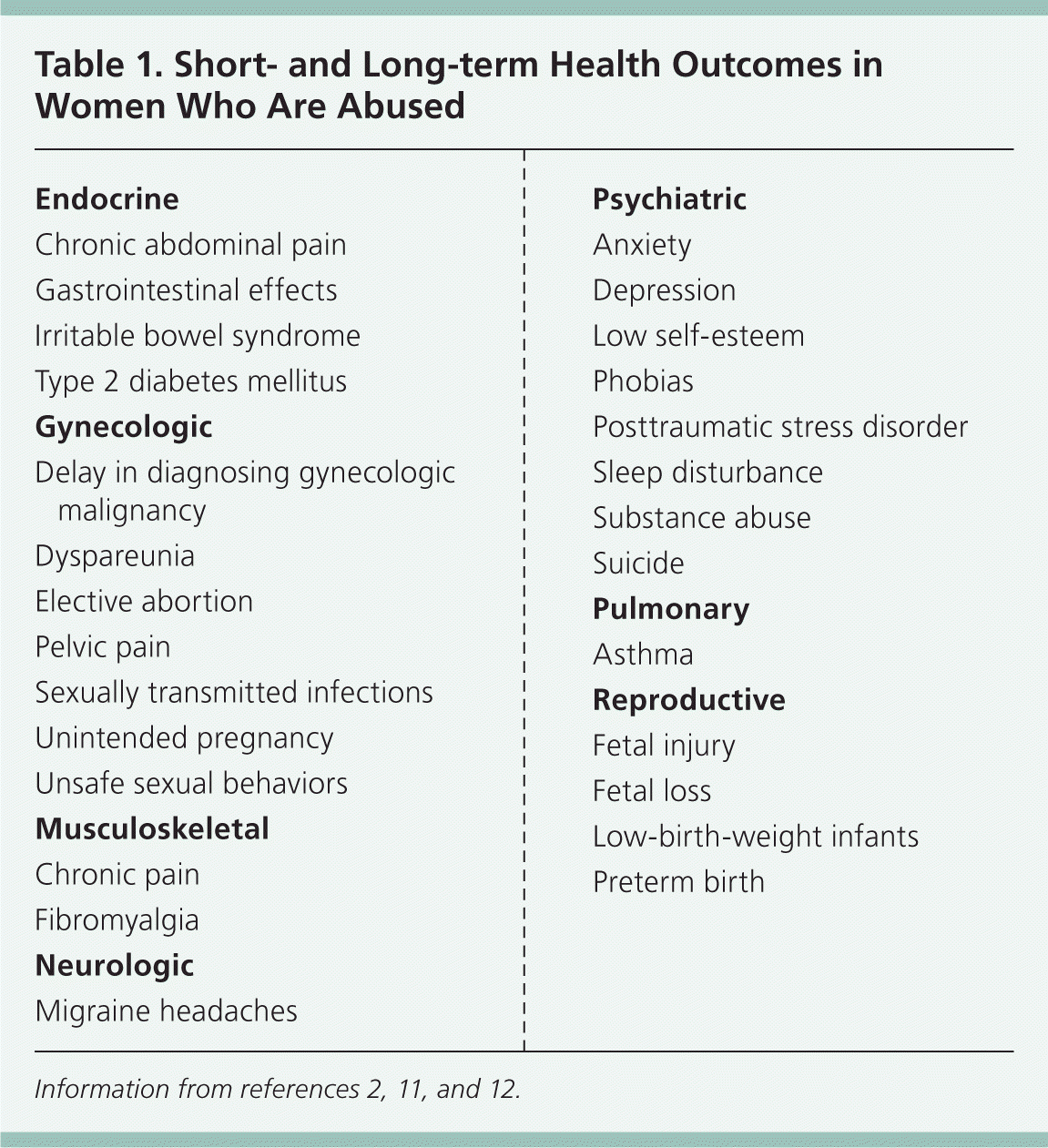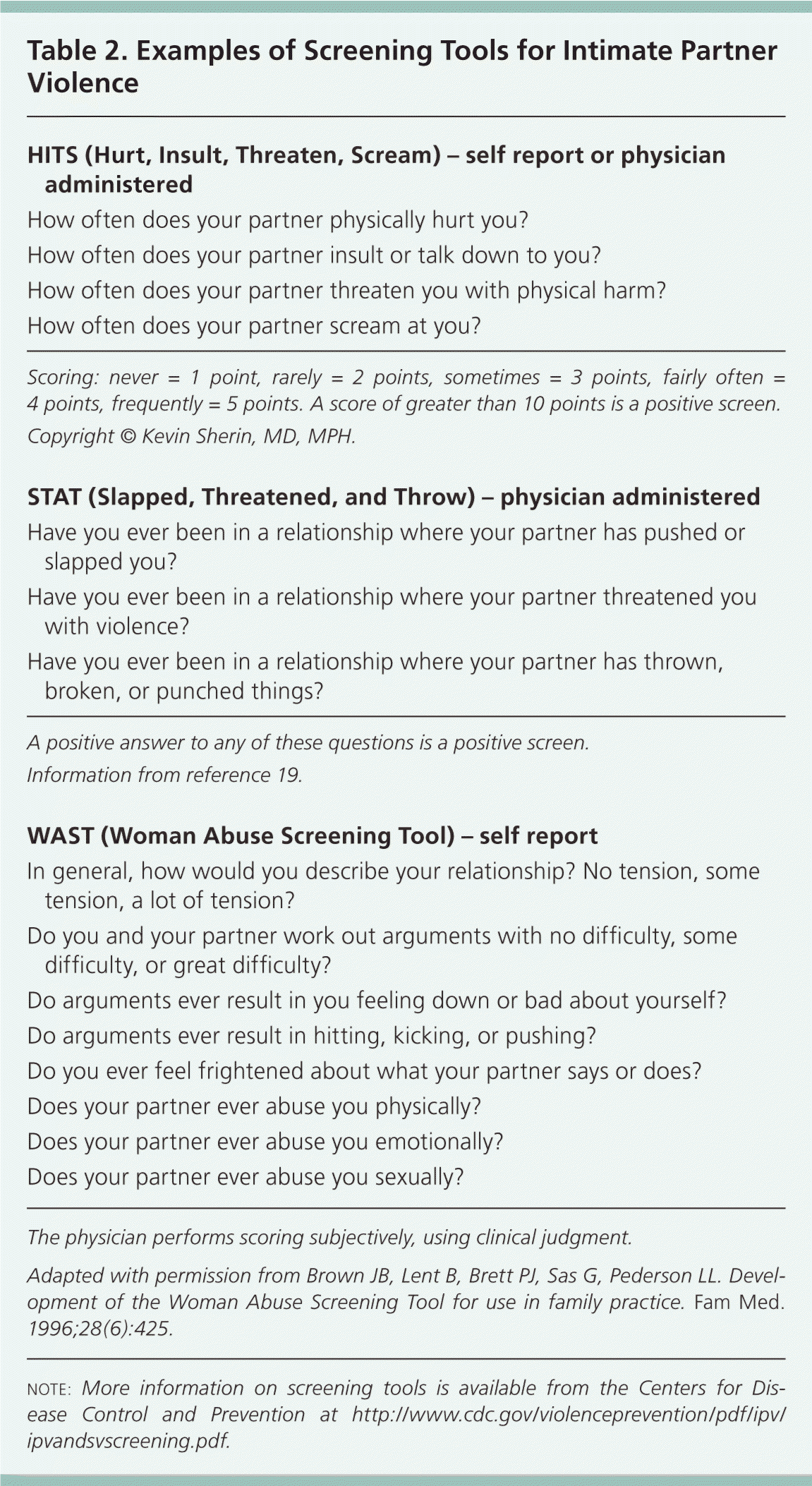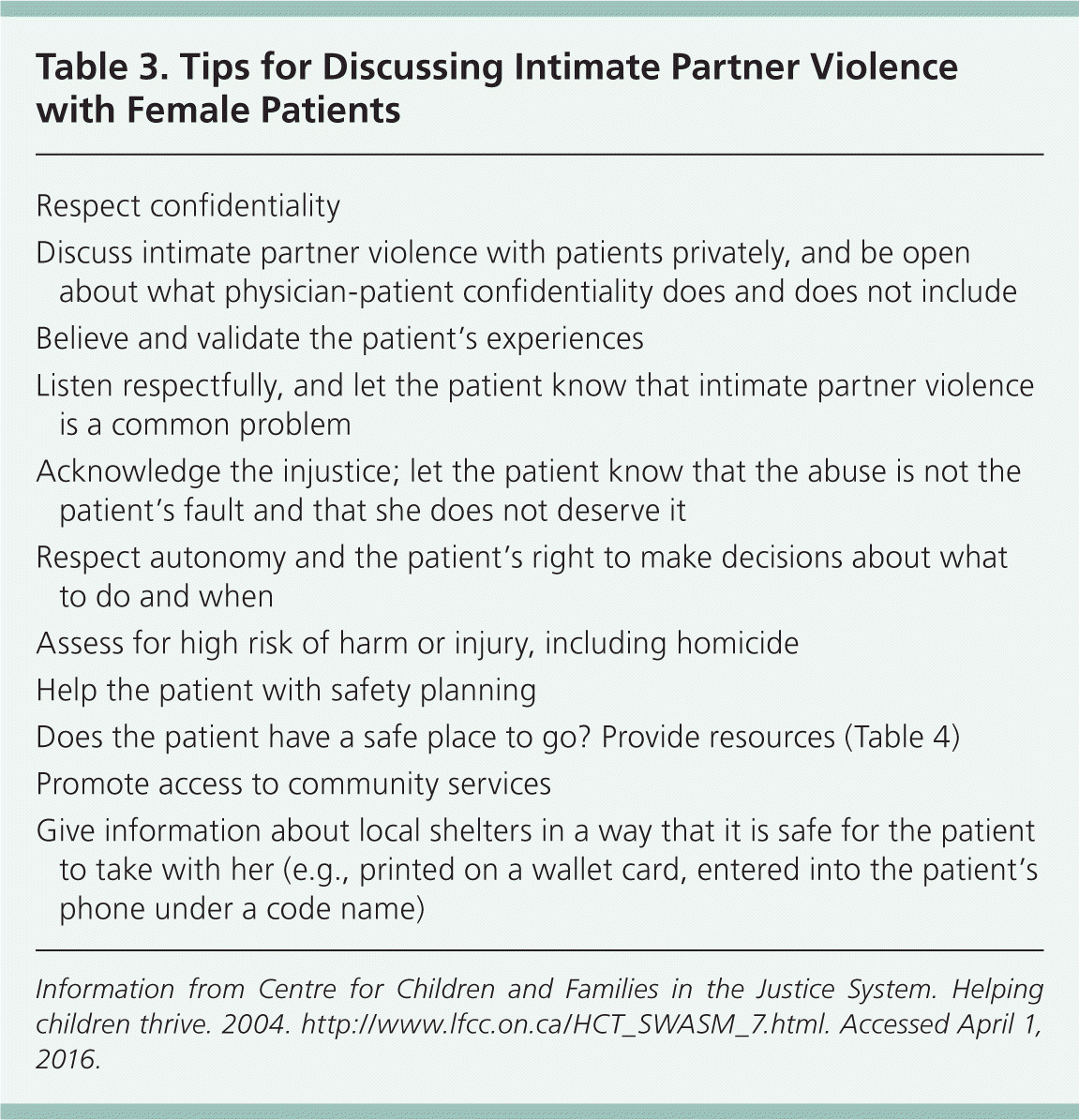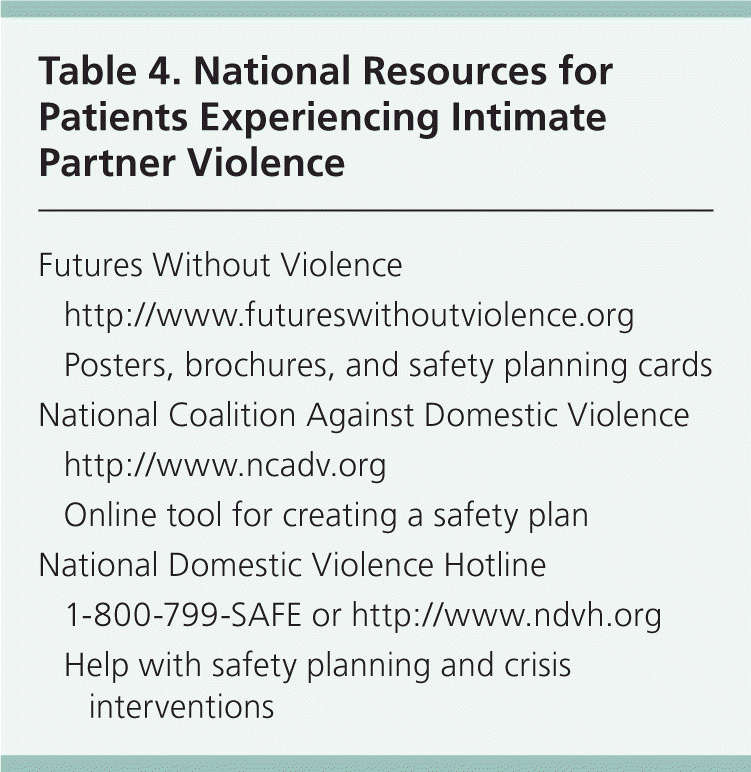
A more recent article on intimate partner violence is available.
Am Fam Physician. 2016;94(8):646-651
Related editorial: Beyond Identification of Patients Experiencing Intimate Partner Violence.
Related letter: The Need for Systems of Care and a Trauma-Informed Approach to Intimate Partner Violence
Patient information: See related handout on intimate partner violence.
Author disclosure: No relevant financial affiliations.
Intimate partner violence (IPV) is a prevalent worldwide health problem, affecting women more commonly than men. IPV is underreported and underrecognized by health care professionals. Even when IPV is recognized, it remains an underaddressed issue. In addition to physical injury and death, IPV causes significant physical and psychiatric health problems commonly treated by family physicians. The U.S. Preventive Services Task Force recommends screening all female patients of childbearing age for IPV. There are several brief screening tools that have been proven effective at detecting IPV and that can be used in the office setting. Identification of IPV allows the physician to provide better care and improves health outcomes for the survivor. Family physician offices should provide patients with local and national resources. Thorough documentation of injuries sustained from abuse is critical. Although caring for patients unready to leave an abusive relationship may be challenging for the physician, continuous, supportive care improves patient outcomes.
Intimate partner violence (IPV) is a prevalent worldwide health problem, affecting women more commonly than men. It can include physical, emotional, sexual, and financial abuse, as well as control over contraception or pregnancy and medical care. IPV occurs in heterosexual and same-sex relationships. Patients who are being abused exhibit chronic physical and emotional symptoms in addition to injuries sustained as a result of physical and sexual violence. They are also at risk of death from homicide. IPV is largely underrecognized and underaddressed as a health issue. The World Health Organization has released guidelines to help physicians respond to IPV in women.1
| Clinical recommendation | Evidence rating | References |
|---|---|---|
| All women of childbearing age should be screened for IPV. There is a low risk of negative effects from screening. | A | 15, 16 |
| Women who screen positive for IPV should receive intervention services. | C | 15, 18, 26 |
| There are multiple screening tools effective for IPV (Table 2). | C | 15, 17, 21 |
Epidemiology
Because IPV is underreported, estimating true prevalence is difficult. Conservative estimates indicate that 20% to 30% of women in the United States have experienced IPV in their lifetime.2–4 More than 10% of female college students have reported unwanted sexual intercourse with a partner.2 IPV tends to be repetitive, with an escalation in frequency and severity over time.3 Homicide is a common consequence of IPV, resulting in more than 1,000 deaths in the United States each year.4,5 The initial episode of IPV usually occurs before 25 years of age.6
Studies have found higher rates of IPV in Native American and Alaska Native women.6 Immigrants have higher rates of IPV, but it is much less likely to be reported or recognized in this population.8 It is also common in same-sex relationships, among transgender women,9 and among women who are survivors of human trafficking.8 The incidence of IPV in men appears to be less than in women, but IPV is more likely to be under-reported in men.3,10
Acute and Chronic Health Outcomes
IPV can lead to acute health outcomes, including acute physical injury and homicide, as well as chronic health burdens. Table 1 lists short- and long-term health outcomes in women who are abused.2,11,12 IPV affects pregnancy outcomes and reproductive health, leading to higher rates of miscarriage, preterm labor, and low-birth-weight infants.11 Health care costs and decreased productivity are significantly increased in survivors of abuse, amounting to an estimated $2.3 to $8.3 billion per year in the United States.6 Long-term consequences of IPV are more common in female survivors than in male survivors.4

| Endocrine |
| Chronic abdominal pain |
| Gastrointestinal effects |
| Irritable bowel syndrome |
| Type 2 diabetes mellitus |
| Gynecologic |
| Delay in diagnosing gynecologic malignancy |
| Dyspareunia |
| Elective abortion |
| Pelvic pain |
| Sexually transmitted infections |
| Unintended pregnancy |
| Unsafe sexual behaviors |
| Musculoskeletal |
| Chronic pain |
| Fibromyalgia |
| Neurologic |
| Migraine headaches |
| Psychiatric |
| Anxiety |
| Depression |
| Low self-esteem |
| Phobias |
| Posttraumatic stress disorder |
| Sleep disturbance |
| Substance abuse |
| Suicide |
| Pulmonary |
| Asthma |
| Reproductive |
| Fetal injury |
| Fetal loss |
| Low-birth-weight infants |
| Preterm birth |
Children living in homes where they witness IPV have the same risk of significant long-term physical and mental health problems as children who have been abused themselves.13,14 Children witnessing IPV can have increased health care costs and hospitalization rates, higher risk of being in an abusive relationship as an adult, lower immunization rates, posttraumatic stress disorder, school-related problems, and substance abuse.13
Screening
RECOMMENDATIONS
In 2013, the U.S. Preventive Services Task Force (USPSTF) began recommending routine screening for IPV in all female patients of childbearing age. The USPSTF indicates that current screening tools for IPV are sensitive and specific, that screening and intervention decrease abuse and harm to patients, and that there is a low risk of negative effects from screening.15,16
A 2014 Cochrane review contradicts the USPSTF and found insufficient evidence that routine screening improves outcomes. It further concluded that there is inadequate proof that routine screening is benign and cautioned that the lack of sensitivity of screening tools may lead to false reassurance by showing lower rates of IPV than the true prevalence.17
The Cochrane review examined fewer studies than the USPSTF, focusing on screening alone and excluding studies such as those of structured clinical interventions. The Cochrane review included only two studies that examined outcomes of screening and found no improvement in health or reduction in IPV rates as late as 18 months after screening. It included only one study that examined possible adverse effects. The authors justified their focus on screening alone by stating that it is unrealistic to have appropriate interventions available in a typical primary care setting. Review of current research, however, shows that even simple interventions, such as providing a wallet card that includes information on IPV, safety planning, or local domestic violence shelters, can improve outcomes.17
Major medical bodies, including the American Academy of Family Physicians, the American Medical Association, and the American College of Obstetricians and Gynecologists, recommend routine screening for IPV and caution that waiting for more definitive research before addressing IPV puts women at risk.18
SCREENING TOOLS
Screening tools are limited by the patient's readiness to disclose the abuse. Some patients may not feel ready to admit that they are in an abusive situation, or may fear retribution from the abuser even with assurances of confidentiality by the clinician.2,8 However, this should not deter physicians from screening patients with one of the multiple screening tools (Table 219,20 ) that have been proven sensitive and specific for identifying IPV.15 Shorter, simpler tools are as effective as longer screening instruments.21

| HITS (Hurt, Insult, Threaten, Scream) – self report or physician administered |
| How often does your partner physically hurt you? |
| How often does your partner insult or talk down to you? |
| How often does your partner threaten you with physical harm? |
| How often does your partner scream at you? |
| Scoring: never = 1 point, rarely = 2 points, sometimes = 3 points, fairly often = 4 points, frequently = 5 points. A score of greater than 10 points is a positive screen. |
| Copyright © Kevin Sherin, MD, MPH. |
STAT (Slapped, Threatened, and Throw) – physician administered |
| Have you ever been in a relationship where your partner has pushed or slapped you? |
| Have you ever been in a relationship where your partner threatened you with violence? |
| Have you ever been in a relationship where your partner has thrown, broken, or punched things? |
| A positive answer to any of these questions is a positive screen. |
| Information from reference19 . |
| WAST (Woman Abuse Screening Tool) – self report |
| In general, how would you describe your relationship? No tension, some tension, a lot of tension? |
| Do you and your partner work out arguments with no difficulty, some difficulty, or great difficulty? |
| Do arguments ever result in you feeling down or bad about yourself? |
| Do arguments ever result in hitting, kicking, or pushing? |
| Do you ever feel frightened about what your partner says or does? |
| Does your partner ever abuse you physically? |
| Does your partner ever abuse you emotionally? |
| Does your partner ever abuse you sexually? |
| The physician performs scoring subjectively, using clinical judgment. |
TALKING TO PATIENTS
Research shows that patients, with and without a history of IPV, favor physicians inquiring about IPV at wellness visits. Although most physicians feel they should screen patients for IPV, only a small percentage actually do so, largely because they feel uncomfortable having such conversations.17,22
Physicians should begin by explaining why they are asking about IPV, whether it be part of screening at a wellness visit or in response to specific physical or mental health issues. The most important aspect of these discussions is for the physician to demonstrate compassion and avoid condescending or judgmental behavior. Direct questioning about specific abuse experiences should be avoided in favor of a more open-ended approach. Simply asking patients what happened or if they feel safe and valued in their relationship can be the best way to open the dialogue.2,23 Table 3 includes tips for discussing IPV with female patients.24

| Respect confidentiality |
| Discuss intimate partner violence with patients privately, and be open about what physician-patient confidentiality does and does not include |
| Believe and validate the patient's experiences |
| Listen respectfully, and let the patient know that intimate partner violence is a common problem |
| Acknowledge the injustice; let the patient know that the abuse is not the patient's fault and that she does not deserve it |
| Respect autonomy and the patient's right to make decisions about what to do and when |
| Assess for high risk of harm or injury, including homicide |
| Help the patient with safety planning |
| Does the patient have a safe place to go? Provide resources (Table 4) |
| Promote access to community services |
| Give information about local shelters in a way that it is safe for the patient to take with her (e.g., printed on a wallet card, entered into the patient's phone under a code name) |
The patient should always be clothed when discussing IPV. The patient's partner or children older than three years should not be present. It may be helpful to establish with patients and those with them ahead of time that it is office policy to conduct a portion of each patient's visit alone.2,17,23 Physicians should be aware of mandatory reporting and confidentiality laws in their state so they can inform patients of any limits to doctor-patient confidentiality at the onset of any discussion. Some states, for instance, include IPV witnessed by children in their mandatory reporting requirements. For more information about state requirements, go to https://www.futureswithoutviolence.org/mandatory-reporting-of-domestic-violence-by-healthcare-providers/.
Approach to Patients in an Abusive Relationship
Patients who screen positive for IPV may respond in unexpected ways. Many will not be ready to leave the relationship, whether it be for emotional or more practical reasons, such as financial or safety concerns (most homicides by an intimate partner occur in the year after the abused partner leaves the relationship). Concern for children and the hope that a partner will change are also common reasons for staying in an abusive relationship.25 Regardless, it is important for physicians to be supportive and provide or refer for intervention services.15,18,26 Risk of immediate harm should be assessed at the time of IPV identification and at all subsequent visits.2,17,23
The assessment of the risk of immediate harm should include the following questions (if patients answer “yes” to at least three of these questions, they are at high risk of harm or injury, with a sensitivity of 83% and a specificity of 56%)27:
Has the physical violence increased over the past six months?
Has your partner used a weapon or threatened you with a weapon?
Do you believe your partner is capable of killing you?
Have you been beaten while pregnant?
Is your partner violently and constantly jealous of you?
Information about safety planning should be offered to the patient. A safety plan helps prepare the patient to leave if the situation acutely worsens, and they are at immediate risk. It may include making copies of personal documents, making copies of keys, securing money, and packing a bag with essential items. The patient should identify a safe place to go (e.g., a relative's house, local domestic violence shelter). Code words should be established with trusted friends or family so that the patient can call and alert them to imminent danger in the presence of the abuser. A list of local and national resources should be provided to the patient, including local shelters and the National Domestic Violence hotline number (800-799-SAFE). If the patient does not feel safe taking a wallet card with this information, important phone numbers may be programmed into the patient's phone under a code name.2,23 Physicians who are too busy or not comfortable enough to help establish a complete safety plan should provide the patient with resources for further assistance (Table 4).

| Futures Without Violence | |
| http://www.futureswithoutviolence.org | |
| Posters, brochures, and safety planning cards | |
| National Coalition Against Domestic Violence | |
| http://www.ncadv.org | |
| Online tool for creating a safety plan | |
| National Domestic Violence Hotline | |
| 1-800-799-SAFE or http://www.ndvh.org | |
| Help with safety planning and crisis interventions | |
An ongoing relationship with the same physician improves patient openness to discussing IPV. Being aware of a patient's experiences with IPV allows the physician to gain insight into the patient's medical and emotional problems, and should prompt the physician to show extra sensitivity with physical examinations (explaining each next step in the examination and getting the patient's approval to move forward is a way of giving the patient back a sense of control over her body). It is critical for the physician to document any injuries thoroughly and provide a detailed record of what happened, including direct quotes from the patient when appropriate. This can aid the patient if charges are pressed.2,23,26,28,29
Prevention
The World Health Organization recommends legislative reform and media campaigns to increase IPV awareness. School-based education programs dealing with dating violence have been shown to reduce unwanted sexual advances. Early intervention services in at-risk families have been shown to reduce mistreatment of children and may reduce violent behaviors later in life. Comprehensive services from the health, legal, and law enforcement sectors should be made available to survivors.25
Data Sources: A literature search was conducted in PubMed using the term intimate partner violence. Key sources included USPSTF recommendations and Cochrane reviews. Search dates: October 2013 and March 2015.